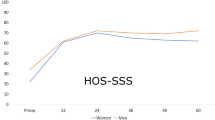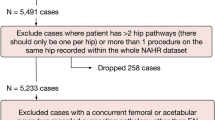Abstract
Purpose
Predictors of outcome after femoroacetabular impingement (FAI) surgery are not well-documented. This study presents data from the Danish Hip Arthroscopy Registry (DHAR) for such analyses. The purpose of this study was to identify predictors of poor outcome after FAI surgery in a Danish FAI population. The primary hypothesis was that older patients, patients with severe cartilage damage and female patients might have inferior outcome results compared with younger patients, patients with minor cartilage damage and male patients.
Methods
Radiological and surgical data as well as patient-reported outcome measures (PROM) from FAI patients in DHAR between January 2012 and May 2015 were collected. PROMs consisting of Copenhagen Hip and Groin Outcome Score (HAGOS), quality of life (EQ-5D), Hip Sports Activity Scale (HSAS) and Numeric Rating Scale (NRS) pain scores were assessed. The patients were divided into three age groups (< 25, 25–39 and ≥ 40 years). Cartilage injuries were classified according to International Cartilage Repair Society (ICRS) (femoral side) and modified Becks (acetabular side) classifications. A non-parametric statistic method was used to analyze the differences between the preoperative and postoperative PROM values.
Results
Data from 2054 FAI procedures in DHAR was collected. 53% of the procedures were done in female patients. All HAGOS sub-scales, EQ-5D, HSAS and NRS pain (rest and walk) demonstrated significant improvements in all age groups at follow-up. Comparison between age groups demonstrated poorer outcomes in both older age groups when compared with the < 25 years age group at 1- and 2-year follow-ups. Higher degrees of femoral and acetabular cartilage injury did have a negative influence on outcome at follow-up. Comparison between genders demonstrated lower preoperative outcomes in females and lower outcome score (HSAS) 1 and 2 years after FAI surgery.
Conclusions
Age above 25 and major cartilage injury might negatively affect the outcome of surgery, however, gender could not be identified as a negative predictor of clinical outcome after FAI surgery, but might negatively affect sports participation in females.
Level of evidence
III, prospective cohort study.
Similar content being viewed by others
References
Griffin DR, Dickenson EJ, O´Donnell J et al (2016) The Warwick Agreement on femoroacetabular impingement syndrome (FAI syndrome): an international consensus statement. Br J Sports Med 50:1169–1176
Ganz R, Parvizi J, Beck M et al (2003) Femoroacetabular impingement: a cause for osteoarthritis of the hip. Clin Orthop Relat Res 417:112–120
Sankar WN, Nevitt M, Parvizi J et al (2013) Femoroacetabular impingement: defining the condition and its role in the pathophysiology of osteoarthritis. J Am Acad Orthop Surg 21(Suppl 1):S7–S15
Dippmann C, Thorborg K, Kraemer O et al (2014) Hip arthroscopy with labral repair for femoroacetabular impingement: short-term outcomes. Knee Surg Sports Traumatol Arthrosc 22(4):744–749
Lund B, Mygind-Klavsen B, Nielsen TG et al (2017) Danish Hip Arthroscopy Registry (DHAR): the outcome of patients with femoroacetabular impingement (FAI). J Hip Preserv Surg 4(2):170–177
Nielsen TG, Miller LL, Lund B, Christiansen SE, Lind M (2014) Outcome of arthroscopic treatment for symptomatic femoroacetabular impingement. BMC Musculoskelet Disord 15:394
Sansone M, Ahldén M, Jónasson P et al (2017) Outcome after hip arthroscopy for femoroacetabular impingement in 289 patients with minimum 2-year follow-up. Scand J Med Sci Sports 27(2):230–235
Öhlin A, Sansone M, Olufemi AR et al (2017) Predictors of outcome at 2-year follow-up after arthroscopic treatment of femoro-acetabular impingement. J Hip Preserv Surg 4(3):224–230
Saadat E, Martin SD, Thornhill TS et al (2014) Factors associated with failure of surgical treatment for femoroacetabular impingement: review of the literature. Am J Sports Med 42(6):1487–1495
Frank RM, Lee S, Bush-Joseph CA et al (2016) Outcomes for hip arthroscopy according to sex and age. A comparative matched-group analysis. J Bone Jt Surg Am 98:797–804
Horner NS, Ekhtiari S, Simunovic N et al (2017) Hip arthroscopy in patients age 40 or older: a systematic review. Arthroscopy 33(2):464–475
Joseph R, Pan X, Cenkus K et al (2016) Sex differences in self-reported hip function up to 2 years after arthroscopic surgery for femoroacetabular impingement. Am J Sports Med 44(1):54–59
Mygind-Klavsen B, Nielsen TG, Maagaard N et al (2016) Danish Hip Arthroscopy Registry: an epidemiologic and perioperative description of the first 2000 procedures. J Hip Preserv Surg 3(2):138–145
Tannast M, Siebenrock KA, Anderson SE (2007) Femoroacetabular impingement: a radiographic diagnosis—what the radiologist should know. AJR Am J Roentgenol 188:1540–1552
Griffin D, Wall P, Realpe A et al (2016) UK FASHIoN: feasibility study of a randomised controlled. Health Technol Assess 20(32):1–172. https://doi.org/10.3310/hta20320
Hjermstad MJ, Fayers PM, Haugen DF et al (2011) Studies comparing Numerical Rating Scales, Verbal Rating Scales, and Visual Analogue Scales for assessment of pain intensity in adults: a systematic literature review. J Pain Symptom Manag 41:1073–1093
Thorborg K, Hölmich P, Christensen R et al (2011) The Copenhagen Hip and Groin Outcome Score (HAGOS): development and validation according to the COSMIN checklist. Br J Sports Med 45:478–491
Thorborg K, Tijssen M, Habets B et al (2015) Patient-Reported Outcome (PRO) questionnaires for young to middle-aged adults with hip and groin disability: a systematic review of the clinimetric evidence. Br J Sports Med 49(12):812
Zampelis V, Ornstein E, Franzén H et al (2014) A simple visual analog scale for pain is as responsive as the WOMAC, the SF-36, and the EQ-5D in measuring outcomes of revision hip arthroplasty. Acta Orthop 85:128–132
Naal FD, Miozzari HH, Kelly BT et al (2013) The Hip Sports Activity Scale (HSAS) for patients with femoroacetabular impingement. Hip Int 23(2):204–211
Beck M, Leunig M, Parvizi J et al (2004) Anterior femoroacetabular impingement: part II. Midterm results of surgical treatment. Clin Orthop Relat Res 418:67–73
Beck M, Kalhor M, Leunig M et al (2005) Hip morphology influences the pattern of damage to the acetabular cartilage: femoroacetabular impingement as a cause of early osteoarthritis of the hip. J Bone Jt Surg Br 87:1012–1018
Konan S, Rayan F, Meermans G et al (2011) Validation of the classification system for acetabular chondral lesions identified at arthroscopy in patients with femoroacetabular impingement. J Bone Jt Surg Br 93:332–336
Nwachukwu BU, Fields K, Chang B et al (2016) Preoperative outcome scores are predictive of achieving the minimal clinically important difference after arthroscopic treatment of femoroacetabular impingement. Am J Sports Med 45(3):612–619
Nwachukwu BU, Chang B, Fields K et al (2017) Defining the “substantial clinical benefit” after arthroscopic treatment of femoroacetabular impingement. Am J Sports Med 45(6):1297–1303
Peters CL, Schabel K, Anderson L, Erickson J (2010) Open treatment of femoroacetabular impingement is associated with clinical improvement and low complication rate at short-term followup. Clin Orthop Relat Res 468(2):504–510
Lind M, Menhert F, Pedersen AB (2009) The first results from the Danish ACL reconstruction registry: epidemiologic and 2 year follow-up results from 5,818 knee ligament reconstructions. Knee Surg Sport Traumatol Arthrosc 17:117–124
Funding
There was no funding.
Author information
Authors and Affiliations
Contributions
All authors made substantial contributions to conception and design, analysis and interpretation of data. TGN made substantial contributions to the acquisition of data, statistical analysis and interpretation of data. All authors have been involved in drafting the manuscript or revising it critically for important intellectual content. All authors have read and approved the final manuscript.
Corresponding author
Ethics declarations
Conflict of interest
The authors declare that they have no competing interests.
Ethical approval
Ethical approval was not sought for the present study. Handling of data from DHAR is approved by the Danish Data Protection Agency and DHAR is approved by the Danish Health Authority.
Informed consent
For this type of study formal consent is not required.
Rights and permissions
About this article
Cite this article
Mygind-Klavsen, B., Lund, B., Nielsen, T.G. et al. Danish Hip Arthroscopy Registry: predictors of outcome in patients with femoroacetabular impingement (FAI). Knee Surg Sports Traumatol Arthrosc 27, 3110–3120 (2019). https://doi.org/10.1007/s00167-018-4941-3
Received:
Accepted:
Published:
Issue Date:
DOI: https://doi.org/10.1007/s00167-018-4941-3




